 We have visited Colombia in 2011 and our original plan was to revisit some of our favourite parts. But due to all the shipping delays, we decided to drive straight to the parts of the country that we have not visited yet. So, as soon as we have our van back, we start driving in a straight line to Medellin.
We have visited Colombia in 2011 and our original plan was to revisit some of our favourite parts. But due to all the shipping delays, we decided to drive straight to the parts of the country that we have not visited yet. So, as soon as we have our van back, we start driving in a straight line to Medellin.
 While we were waiting for our van to arrive, we of course used the opportunity to visit the town of Cartagena again. When we were here in 2011, it was already pretty popular but nothing compared to these days. We were told that it is now one of the favourite destinations for travellers from all over Latin America. The neighborhood, Getsemani, where we stayed last time was a poor and slightly dangerous place with just a couple of spots that were being renovated. Today it has become a very colourful and peaceful place, full of murals and other art where tourists hang out day and night. On our first visit this time, we don’t even make it to the old town. Team ‘wildlife spotting’ has discovered that there are sloths and monkeys hidden in the city park. The humidity (95 pct) and heat (38 degrees) are just as bad here as in Central America, so after the sloth spotting we quickly withdraw to our airconditioned apartment. The next day, we do make it to the old town and wander around for a while watching the beautifully restored buildings, until an afternoon thunderstorm drenches us and floods the town. Once this was one of the most important ports for shipping gold & treasures from the ‘new world’ to Spain. The wealth of those times is still visible in the gorgeous buildings today. Pirates, like Sir Francis Drake loved this town! But, unlike the old Panama City, this town was never destroyed.
While we were waiting for our van to arrive, we of course used the opportunity to visit the town of Cartagena again. When we were here in 2011, it was already pretty popular but nothing compared to these days. We were told that it is now one of the favourite destinations for travellers from all over Latin America. The neighborhood, Getsemani, where we stayed last time was a poor and slightly dangerous place with just a couple of spots that were being renovated. Today it has become a very colourful and peaceful place, full of murals and other art where tourists hang out day and night. On our first visit this time, we don’t even make it to the old town. Team ‘wildlife spotting’ has discovered that there are sloths and monkeys hidden in the city park. The humidity (95 pct) and heat (38 degrees) are just as bad here as in Central America, so after the sloth spotting we quickly withdraw to our airconditioned apartment. The next day, we do make it to the old town and wander around for a while watching the beautifully restored buildings, until an afternoon thunderstorm drenches us and floods the town. Once this was one of the most important ports for shipping gold & treasures from the ‘new world’ to Spain. The wealth of those times is still visible in the gorgeous buildings today. Pirates, like Sir Francis Drake loved this town! But, unlike the old Panama City, this town was never destroyed.
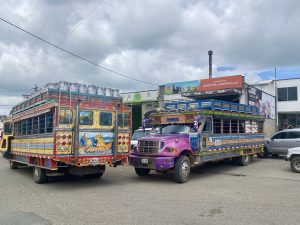 Cartagena was nice but we are more than happy when we finally get back our van and can start driving. The roads in Colombia, are a lot better than expected and the traffic is definitely not as bad/crazy as we had heard. We also notice some new traffic signs and particular trucks and busses that look a lot like ‘pimped’ versions of Chevrolet pick-up trucks. Something else that we notice is that the rainy season has now finally arrived. We had seen a couple of thunderstorms in Panama but only in Colombia (and a month late) did we really get our daily afternoon dose of downpours.
Cartagena was nice but we are more than happy when we finally get back our van and can start driving. The roads in Colombia, are a lot better than expected and the traffic is definitely not as bad/crazy as we had heard. We also notice some new traffic signs and particular trucks and busses that look a lot like ‘pimped’ versions of Chevrolet pick-up trucks. Something else that we notice is that the rainy season has now finally arrived. We had seen a couple of thunderstorms in Panama but only in Colombia (and a month late) did we really get our daily afternoon dose of downpours.
 Driving into Medellin is an interesting experience but not nearly as chaotic as we had expected. The most impressive is the sheer size of the city. Situated in a valley we see buildings creep up the hills on all sides. We leave our van parked next to a hostel during our whole stay, because the super-efficient metro is the way to travel in Medellin. We noticed that the name Medellin still invokes fear and memories of violence with many people. It used to be one of the dangerous places on the planet at the end of the 20th century. These days it is a big city like so many around the world, with many travelers safely visiting. Although we must say that we were quite surprised by how ‘gritty’ (drug addicts, prostitutes and shady characters everywhere), the Plaza Botero area -a main tourist attraction- still is. When we were in Colombia last time, we discovered the artist Botero and really liked his special style. It is really cool to now visit his home town and see the park full of sculptures. Our favorite sculpture, ‘The Pajaro’ is not found on ‘his Plaza Botero’ but elsewhere in the city.
Driving into Medellin is an interesting experience but not nearly as chaotic as we had expected. The most impressive is the sheer size of the city. Situated in a valley we see buildings creep up the hills on all sides. We leave our van parked next to a hostel during our whole stay, because the super-efficient metro is the way to travel in Medellin. We noticed that the name Medellin still invokes fear and memories of violence with many people. It used to be one of the dangerous places on the planet at the end of the 20th century. These days it is a big city like so many around the world, with many travelers safely visiting. Although we must say that we were quite surprised by how ‘gritty’ (drug addicts, prostitutes and shady characters everywhere), the Plaza Botero area -a main tourist attraction- still is. When we were in Colombia last time, we discovered the artist Botero and really liked his special style. It is really cool to now visit his home town and see the park full of sculptures. Our favorite sculpture, ‘The Pajaro’ is not found on ‘his Plaza Botero’ but elsewhere in the city.
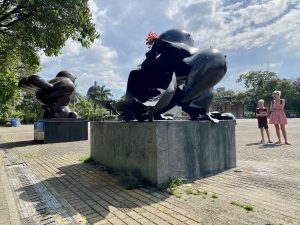 The original Pajaro sculpture was destroyed when a bomb exploded during a festival (killing 23 persons) in the violent 90’s. The artist made a new version but demanded that it be placed right next to the damaged one, to show that the people of Medellin will never give in to the violence!
The original Pajaro sculpture was destroyed when a bomb exploded during a festival (killing 23 persons) in the violent 90’s. The artist made a new version but demanded that it be placed right next to the damaged one, to show that the people of Medellin will never give in to the violence!
 Our favourite spot in Medellin is Comuna 13. Once one of the most dangerous places in the world, similar to the worst favelas in Brazil but now the biggest tourist attraction in Medellin. There are a lot of ugly stories to be told about ‘today’s tourism’, but this is such a nice story of how it completely turned around a whole area of Medellin. Today the majority of the inhabitants works in some tourism related business or another. And the Comuna is one of the most relaxed places in town. Before leaving town we still want to explore a part of the ‘metro network’ that we have not explored yet: the cable carts. They go from the different valleys to high in the hills and some lines even go over several valleys. They are a convenient (and sometimes the only) way to reach some of the most remote parts of town. For us they are a nice way to get an impression of the enormous size of the city.
Our favourite spot in Medellin is Comuna 13. Once one of the most dangerous places in the world, similar to the worst favelas in Brazil but now the biggest tourist attraction in Medellin. There are a lot of ugly stories to be told about ‘today’s tourism’, but this is such a nice story of how it completely turned around a whole area of Medellin. Today the majority of the inhabitants works in some tourism related business or another. And the Comuna is one of the most relaxed places in town. Before leaving town we still want to explore a part of the ‘metro network’ that we have not explored yet: the cable carts. They go from the different valleys to high in the hills and some lines even go over several valleys. They are a convenient (and sometimes the only) way to reach some of the most remote parts of town. For us they are a nice way to get an impression of the enormous size of the city.
 As much as we liked the city, we are also very happy to leave it for our next destination in the countryside: Jardin. The main reason, we came here was to look for a very special bird but we completely fell in love with the colorful town, the coffee, ice cream, cinnamon buns, chocolate bread. And the lovely Las Flores hostal, in whose garden we were allowed to camp. In fact the town of Jardin would become our new favourite town in Colombia.
As much as we liked the city, we are also very happy to leave it for our next destination in the countryside: Jardin. The main reason, we came here was to look for a very special bird but we completely fell in love with the colorful town, the coffee, ice cream, cinnamon buns, chocolate bread. And the lovely Las Flores hostal, in whose garden we were allowed to camp. In fact the town of Jardin would become our new favourite town in Colombia.
 We go on a nice hike around town looking for waterfalls and some good views around town. Jardin is our first town in the famous ‘coffee region’ of Colombia. It is said, that it is virtually impossible to have a bad cup of coffee in this part of the world.
We go on a nice hike around town looking for waterfalls and some good views around town. Jardin is our first town in the famous ‘coffee region’ of Colombia. It is said, that it is virtually impossible to have a bad cup of coffee in this part of the world.
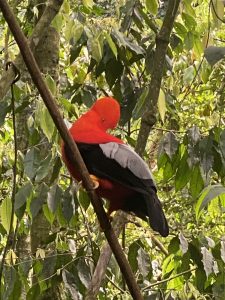 The main reason for our visit however is the ‘Gallito de las Rocas’ (Andean Cock of the Rock). This very beautiful bird is usually very hard to spot. But in the town of Jardin, they are all around. We already saw a couple of them on our hikes around town. But the real treat is visiting a ‘lek’. A ‘lek’ is a place where the males gather to compete and put on a show for the ladies. In just a couple of hours, we see probably two dozen of different males parading in the trees. The ladies did not show up this time but that did not stop the males in their performance at all!
The main reason for our visit however is the ‘Gallito de las Rocas’ (Andean Cock of the Rock). This very beautiful bird is usually very hard to spot. But in the town of Jardin, they are all around. We already saw a couple of them on our hikes around town. But the real treat is visiting a ‘lek’. A ‘lek’ is a place where the males gather to compete and put on a show for the ladies. In just a couple of hours, we see probably two dozen of different males parading in the trees. The ladies did not show up this time but that did not stop the males in their performance at all!
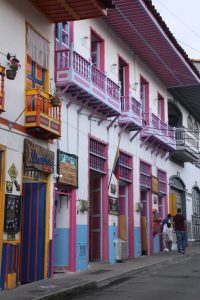 From Jardin we continue to the most famous part of the coffee region around the town of Salento but not without stopping at Filandia. This town, is less famous than Salento but it is gorgeously situated on the top of a hill with views all around. We arrive on a Sunday afternoon during an extended weekend so it seems half of Colombia is there too. The weather is very stormy again and we see several thunderstorms pass through the mountains and valleys all around. While we are looking for a place to sleep on the outskirts of town, we are approached by other visitors. They congratulate us on our “beautiful van’ and are interested in all of its features. For the first time since the US, we notice that local people are also really into travelling with a camper van. This will not be the last time, that people ask to see our camper set up in Colombia. It will also not be the last time that these people warn us about the current ‘security situation’ in the country. After two decades of strong decrease, violent crime seems to be on the rise again…And everybody is pointing fingers to “the millions of Venezuelan refugees that have entered Colombia the last years”. Now, where did we hear that tune before?
From Jardin we continue to the most famous part of the coffee region around the town of Salento but not without stopping at Filandia. This town, is less famous than Salento but it is gorgeously situated on the top of a hill with views all around. We arrive on a Sunday afternoon during an extended weekend so it seems half of Colombia is there too. The weather is very stormy again and we see several thunderstorms pass through the mountains and valleys all around. While we are looking for a place to sleep on the outskirts of town, we are approached by other visitors. They congratulate us on our “beautiful van’ and are interested in all of its features. For the first time since the US, we notice that local people are also really into travelling with a camper van. This will not be the last time, that people ask to see our camper set up in Colombia. It will also not be the last time that these people warn us about the current ‘security situation’ in the country. After two decades of strong decrease, violent crime seems to be on the rise again…And everybody is pointing fingers to “the millions of Venezuelan refugees that have entered Colombia the last years”. Now, where did we hear that tune before?
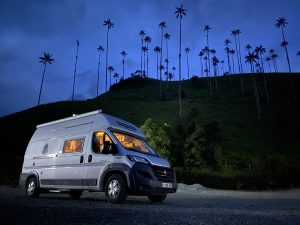 Our next stop is Valle del Cocora. this place has become incredibly popular, mainly because of social media. We heard it feels like a big festival every weekend. To avoid this ‘weekend craziness’, we planned to visit during a Tuesday. However, we didn’t take into account the ‘long weekend’ and so when we drive in on Monday afternoon, we are in the middle of the ‘big end of weekend exit’.
Our next stop is Valle del Cocora. this place has become incredibly popular, mainly because of social media. We heard it feels like a big festival every weekend. To avoid this ‘weekend craziness’, we planned to visit during a Tuesday. However, we didn’t take into account the ‘long weekend’ and so when we drive in on Monday afternoon, we are in the middle of the ‘big end of weekend exit’.
We are allowed park the van for the night right next to the National Park. And for hours until long after dark we watch the weekend crowds leave, until there’s only two vans left in the parking lot. As the evening falls, the storm clouds move in again and we are treated to wonderful light show, with lightning flashes lighting up the palm trees in the valley.
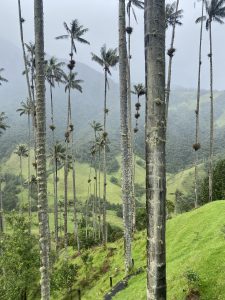 The next morning, we plan to set out early to hike into the park. We hike away from the crowds up to 3000m into the Cloud forest. The Instagram pictures we had seen, did not lie. It is gorgeous! But the photogenic wax palm groves hide a sad truth. All these palms (often hundreds of years old) are slowly dying. They can’t survive without the Cloud forest vegetation surrounding them. Now, with all the other trees gone, their days are numbered too…
The next morning, we plan to set out early to hike into the park. We hike away from the crowds up to 3000m into the Cloud forest. The Instagram pictures we had seen, did not lie. It is gorgeous! But the photogenic wax palm groves hide a sad truth. All these palms (often hundreds of years old) are slowly dying. They can’t survive without the Cloud forest vegetation surrounding them. Now, with all the other trees gone, their days are numbered too…
From the Valle de Cocora, we continue to Salento,probably the most famous of the Eje Cafetero villages. But to be honest we liked the other villages better. Maybe it was the fact that the weather was not cooperating. There was one constant however: great coffee!
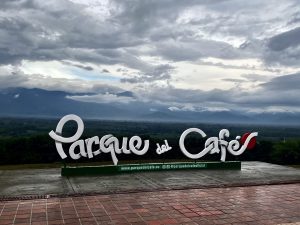 And coffee was also the theme for our next stop. We have a little surprise for the kids again. through Instagram (amazing how this platform has become a source of inspiration on this trip), we found out that there is a theme park dedicated to all things coffee. It is actually owned by the cooperation of coffee planters. The park has a cool mix between rides that we used to have at home in the 1980’s and some brand-new thrill rides. Everybody (before and in the park) told us that we definitely needed to visit ‘the show’. And we do not regret doing so. In this one hour ‘Cofee the musical’, we are guided through the history of coffee making in Colombia. When the usual afternoon rainstorm hits the park we visit another show where we learn how to make the best coffee. Turns out that we actually remember more from this entertaining show than from the more serious workshop we did earlier in Guatemala.
And coffee was also the theme for our next stop. We have a little surprise for the kids again. through Instagram (amazing how this platform has become a source of inspiration on this trip), we found out that there is a theme park dedicated to all things coffee. It is actually owned by the cooperation of coffee planters. The park has a cool mix between rides that we used to have at home in the 1980’s and some brand-new thrill rides. Everybody (before and in the park) told us that we definitely needed to visit ‘the show’. And we do not regret doing so. In this one hour ‘Cofee the musical’, we are guided through the history of coffee making in Colombia. When the usual afternoon rainstorm hits the park we visit another show where we learn how to make the best coffee. Turns out that we actually remember more from this entertaining show than from the more serious workshop we did earlier in Guatemala.
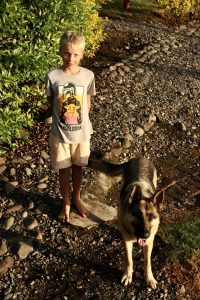 From the coffee region, we start heading south towards the border with Ecuador. But not without a stop in a place that we have heard about ever since we started our travels here in South America: La Bonanza. This is the first of the ‘overlander gathering places’ of which there seem to be quite a couple in South America. Our timing is a bit unfortunate, as the host family is just about to leave for a visit to their home country Morocco. But we have a great time anyway and get to know plenty of other overlanders. Sometimes, we get the impression that we are all alone doing this but then we get to these places where everybody congregates and it’s great for exchanging info and stories.
From the coffee region, we start heading south towards the border with Ecuador. But not without a stop in a place that we have heard about ever since we started our travels here in South America: La Bonanza. This is the first of the ‘overlander gathering places’ of which there seem to be quite a couple in South America. Our timing is a bit unfortunate, as the host family is just about to leave for a visit to their home country Morocco. But we have a great time anyway and get to know plenty of other overlanders. Sometimes, we get the impression that we are all alone doing this but then we get to these places where everybody congregates and it’s great for exchanging info and stories.
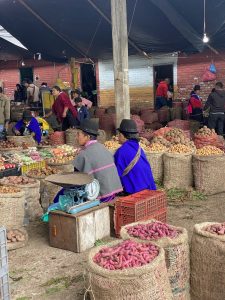 When passing through this part of Colombia it is a must to visit the weekly market of Silvia. Very similar to the Chicastenago market in 8 Guatemala, the Misak indigenous people here, descend each Tuesday from their mountain villages to sell their produce and buy stocks. The tradititional dress of the Misak, makes for some great people watching. But it is also a great opportunity for grocery shopping: very tasty, cheap and fresh from the farm. Around noon, the fully loaded ‘Chivas’ (local busses) start heading back to the villages in the mountains.
When passing through this part of Colombia it is a must to visit the weekly market of Silvia. Very similar to the Chicastenago market in 8 Guatemala, the Misak indigenous people here, descend each Tuesday from their mountain villages to sell their produce and buy stocks. The tradititional dress of the Misak, makes for some great people watching. But it is also a great opportunity for grocery shopping: very tasty, cheap and fresh from the farm. Around noon, the fully loaded ‘Chivas’ (local busses) start heading back to the villages in the mountains.
The situation in the south of Colombia is a bit unstable again. There have been several bombings and raids on police stations in the past couple of months. It’s not really clear if these were the works of the FARC or organized crime. We get the advice to drive straight from La Bonanza to the border with Ecuador and to not leave the Pan American highway. In one long day we drive down to the border town of Ipiales. It’s a beautiful drive with plenty of entertainment.
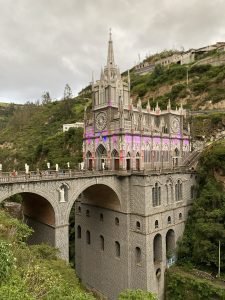 Our last stop in Colombia is Ipiales, a rather bland border town, like we have seen a couple already. But Ipiales has one big attraction. The Las Lajas church is built in the middle of a scenic canyon. After a full day drive we arrive just before sunset and are still able to see it before it turns into a disco or Disneyland like you wish.
Our last stop in Colombia is Ipiales, a rather bland border town, like we have seen a couple already. But Ipiales has one big attraction. The Las Lajas church is built in the middle of a scenic canyon. After a full day drive we arrive just before sunset and are still able to see it before it turns into a disco or Disneyland like you wish.
We have one peaceful night in Colombia and the next morning we get ready to move on to the next country. A country that has gotten a very bad reputation in the last year before our visit.
